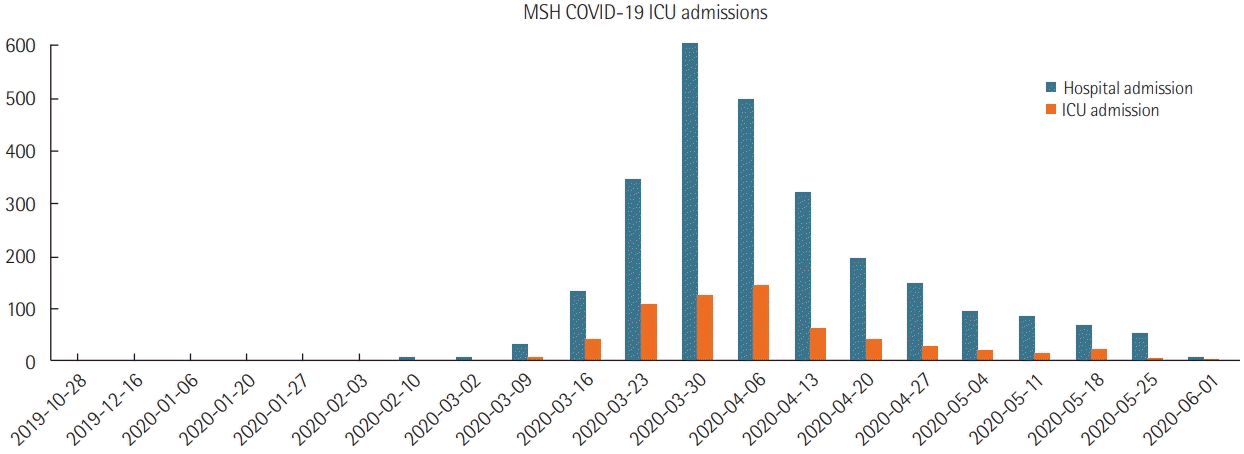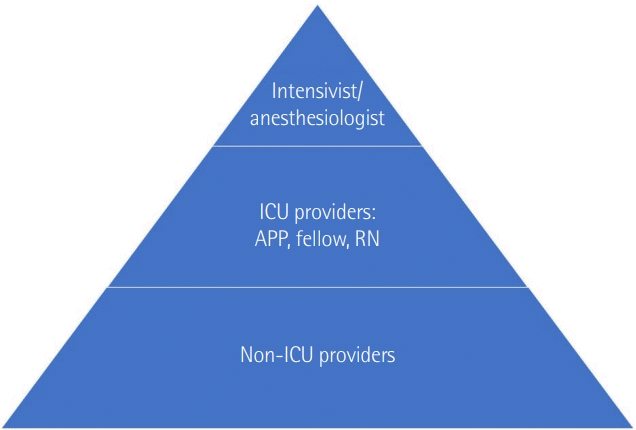INTRODUCTION
Severe acute respiratory syndrome coronavirus 2 (SARS-CoV-2) is a novel respiratory virus of the Coronaviridae family of enveloped, single-stranded RNA viruses and caused the coronavirus disease 2019 (COVID-19). First identified in China in December 2019, COVID-19 became a pandemic in 2020, leading to the largest public health crisis in decades. The first COVID-19 case in the United States (US) was reported in January 2020. By March 2020, COVID-19 cases were identified in all 50 states, District of Columbia, Puerto Rico, Guam, Northern Marianas, and the US Virgin Islands.
New York City (NYC) was the epicenter of the US COVID-19 outbreak. As of February 22, 2021, there were 1,590,000 diagnosed cases and 46,346 deaths [
1]. The rapid increase in cases necessitated an unprecedented increase in critical care capacity and development of institutional guidelines for COVID-19 care. In the present study, how increased ICU capacity and the process for creating, disseminating, and revising guidelines for critically ill COVID-19 patients at Mount Sinai Health System (MSHS) are discussed. The aim is to provide a possible roadmap for other institutions to quickly scale up resources for managing critically ill COVID-19 patients.
MATERIALS AND METHODS
This was a retrospective review of the response of Mount Sinai Hospital to the COVID-19 pandemic and was exempt from IRB Review. The present manuscript was descriptive in design to explain the efforts made by the Mount Sinai Hospital (MSH) to prepare for the COVID-19 pandemic. Because no patients were involved in policy initiative for the COVID surge management, IRB approval was not required.
MSHS, comprised of the Icahn School of Medicine at MSH and eight hospitals with more than 3,800 inpatient beds and more than 42,000 employees, is one the largest health systems in the US. The Institute for Critical Care Medicine (ICCM) at MSH is comprised of seven adult ICUs with over 6,000 admissions annually as well as several team-based services. The ICCM led the COVID-19 critical care response within MSH. More than 45 critical care faculty within the ICCM are responsible for staffing subspecialty ICUs and include several teams such as the rapid response team (RRT), vascular access team, difficult airway response team (DART), patient safety quality team, clinical research team, and post-ICU recovery clinic.
Providing care for a rapidly increasing number of critically ill patients with acute respiratory failure due to a highly contagious viral illness requires guidelines to inform care and maximize healthcare provider safety. ICCM, Department of Emergency Medicine, Department of Anesthesiology, Perioperative and Pain Medicine, and the Infection Prevention team helped develop guidelines by referencing and adapting professional society guidelines. These guidelines were continuously revised and published on a systemwide COVID-19 website accessible to all hospital employees without the need for in-network access.
DISCUSSION
The 2015 American Hospital Association report estimated that more than 28,800 intensivists delivered ICU care in the US. COVID-19 created a surge in critically ill patients, resulting in hospitals searching for additional staff [
2,
3]. When the MSH ICU capacity was increased from 7 to 11 adult ICUs, 1–2 attendings, 1–2 advanced care practitioners (APPs), 1–2 fellows, and 1–2 residents per 12-hour shift with 24/7 in house intensivist coverage were on duty [
4,
5]. At least one of the two attendings in each ICU was an adult intensivist, the other was from anesthesiology, surgery, cardiothoracic surgery, neurosurgery, neurology, pediatric ICU, or neonatal ICU.
Figure 2 shows the force multiplier pyramid and
Table 4 shows the staff deployed to COVID ICUs. Staff shortages were addressed by employing tiered staffing models and training staff from noncritical care areas to serve in critical care areas under intensivist supervision. Travel nurses helped supplement staffing in all ICUs. Equipment such as ventilators, medication, and tube feeding pumps were deployed based on need [
6,
7].
During the COVID-19 surge, the ICU bed capacity was doubled from 104 to 208. All seven adult ICUs became COVID-19 ICUs. All ICU rooms were converted to negative pressure rooms with HEPA (high efficiency particulate air) filters with outside exhaust and redesigned to accommodate up to two patients. Two ICUs were changed to post-anesthesia care units (PACUs), designated as COVID-19-negative, and were staffed by PACU anesthesiologists, pain management fellows, and intensivists (
Table 1). A space formerly used as an ICU reopened as a COVID-19-negative neuroscience ICU and was staffed by neurosurgeons, intensivists, neurologists, and neurosurgery residents. Two medical/surgery units were repurposed as COVID-19-positive ICUs. This unit utilized anesthesia machines as ventilators due to ventilator shortage and was co-managed by anesthesiologists and intensivists (
Supplementary Material 1).
Establishing a new ICU usually requires years of planning, development, investment, and training. This is the first report of creating a de novo anesthesiology-run ICU within days. A location that already had a supply of medical gas, waste pipelines, and an uninterrupted power source was chosen. A telemetry unit was converted to an ICU because it had network interface and a central monitoring station that allowed for remote vital sign monitoring; alarm notification for patient decompensation; and vitals, medication records, and ventilator settings that integrated with the electronic health records. Details of how a stepdown unit was converted into an anesthesia-led critical care unit are described in
Supplementary Material 1.
The greatest challenge in converting medical/surgical stepdown beds into ICUs was lack of patient visibility. Doors were kept closed to maintain negative pressure and minimize viral spread. Although windows were added to the doors, patient visibility was inadequate. Audio and visual equipment with a staffed monitoring station were added to many rooms. Tablets allowing video conferencing were attached to walls and focused on both the patient and vital sign monitors to allow audiovisual “spot checks.” Communicating critical information and calling for help from behind closed doors necessitated a hands-free device compatible with personal protective equipment (PPE). Nursing staff was familiar with Vocera (Vocera, San Jose, CA, USA), so the system was expanded to include physicians. Low-tech solutions such as whiteboards and dry erase markers allowed writing of critical information on windows. Early in the pandemic, resources were limited, and webcams were not available; however, webcams were eventually installed in COVID-19 patient rooms and proved extremely helpful to monitor patients.
The most important part of the de novo anesthesiology-run ICU was building a team of individuals from different departments with various levels of training. Nurses assigned to this unit were from a medical/surgical floor and were not trained in critical care. One ICU nurse per shift was assigned as an educator [
4]. A de-emphasis on title and role was paramount for seamless teamwork and reduced unnecessary exposure and PPE use. Anesthesiology and nursing collaborated to minimize multiple room entries by pairing one person entering and calling out information or needed equipment to a teammate outside who would record information or gather supplies. Intravenous infusion pumps with extra-long tubing were used for access to each room.
MSH has an intensivist-led central venous access service that facilitates tunneled and non-tunneled central venous catheter placement. This service was expanded with the addition of two cardiothoracic anesthesiologists who were deployed to free intensivists to focus on patient care. Dedicated proning teams were created for acute respiratory distress syndrome (ARDS) patients (a team comprised of surgical technicians who were available because elective procedures were suspended). This was overseen by a designated team within ICCM and deployed via Vocera and available 24/7 [
8,
9]. All ICCM faculty, house staff, and nurses were instructed on safe proning practices including simulation sessions.
Palliative care physicians were placed in all COVID-19 ICUs to assist with family meetings and discussions regarding care goals. Social workers facilitated family meetings via video conferencing. Tablets were placed in each ICU room to facilitate video communication between medical teams, families, and patients. ICCM RRT respond to decompensating patients in the hospital. Normally, this team includes an intensivist, critical care fellow, nurse practitioner, and respiratory therapist. During the COVID-19 outbreak, the team expanded to include two certified registered nurse anesthetist during the day and an interventional radiology or anesthesiology resident at night. CRNAs and APPs from outside institutions provided additional help.
Staff deployed to COVID-19 ICUs were required to perform new roles and learn new processes at an unprecedented speed. The ability to rapidly train and orient staff from a variety of backgrounds, disciplines, and from within and outside MSH posed a significant challenge [
10,
11]. To address this, a training and reference manual, the ICCM handbook, was created. The target audience was medical staff outside critical care (internal medicine, surgery, anesthesiology, interventional radiology, and pediatrics) [
12] who had volunteered for COVID duty.
The handbook provided a simple yet comprehensive guide to: (1) complement COVID-19 educational training [
13], (2) review before deployment to COVID-19 ICUs, (3) provide justin-time training , and (4) serve as a simple reference for experienced providers. No precedent existed at the time of handbook preparation; thus, initial topics were based on review of existing protocols from institutions in Italy and US, and from references from prior respiratory viral pandemics (including MERS, SARS, and influenza) [
14]. Topics included staff safety, PPE use, patient transport, sample collection, pharmacologic treatment, airway management and resuscitation, protocol for extended PPE use, ARDS management, and daily workflow in COVID-19 ICUs.
The handbook consisted of a table of contents, a three-page summary for quick reference, and an appendix with protocols (
Supplementary Material 2). Protocols were based on state, critical care society, and system guidelines and were structured with illustrations and step-by-step instructions. Sample collection and PPE donning/doffing instructions included illustrations from the centers for disease control and prevention, and intubation and cardiac arrest protocols included a list of needed supplies. The handbook was circulated via the publicly accessible MSHS COVID-19 staff resource website [
15].
The first week of the COVID-19 crisis in NYC made it evident that institutional guidelines for intubation of COVID-19-positive patients were needed to ensure maximum frontline worker safety. Prior to crisis onset, ICCM developed a DART including critical care, emergency, anesthesiology, and otolaryngology. Each member reviewed literature [
16,
17] and guidelines released by the Society for Critical Care Medicine and the Anesthesia Patient Safety Foundation [
12,
18] to develop COVID19-specific airway management guidelines.
DART addressed anticipated ventilator shortages [
19] and safety of noninvasive ventilatory strategies. While delaying intubation could increase the risk of acute catastrophic decompensation and respiratory arrest, controversy remained over the extent of increased viral aerosolization [
20,
21]. Airway management dictates preparation for intubation as well as multiple backup plans for unanticipated difficulties [
22]. “Go bags” were organized for intubation to minimize supply contamination and waste. Anticipated difficult intubations included larger “go bags” with additional supplies.
Many professional society guidelines have the most experienced person perform laryngoscopy for COVID-19 intubations [
12,
18,
23]. Our guidelines recommended that COVID-19 intubations be performed by two experienced operators, one for laryngoscopy and the other to assist. COVID-19 intubation teams included intensivists, anesthesiology attendings, anesthesiology senior residents, and nurse anesthetists. DART activations, available for backup at MSH 24/7, assembled critical care, anesthesiology, and otolaryngology physicians for difficult intubations. COVID-19 DART intubations allowed otolaryngologists into the room only if a surgical airway was needed to limit the number of providers exposed and to preserve PPE. Guideline dissemination occurred via email to all departments who provide airway management and through virtual departmental conferences and grand rounds. In addition, high-fidelity simulation sessions were offered in small groups to all airway providers across departments followed by debriefing to evaluate and reinforce adherence to protocols. MSHS COVID-19 intubation guidelines, updated as of April 16, 2020, are included in
Supplementary Material 2.
MSH responded to the COVID-19 surge by quickly expanding critical care bed capacity from 104 to over 200 ICU beds. Teamwork across multiple disciplines and guidelines for airway management, cardiac arrest, anticoagulation, vascular access, and proning was critical to hospital success. Non-ICU staff were used to help reinforce the ICU staff and open additional ICUs.






 PDF
PDF Citation
Citation Print
Print



 XML Download
XML Download